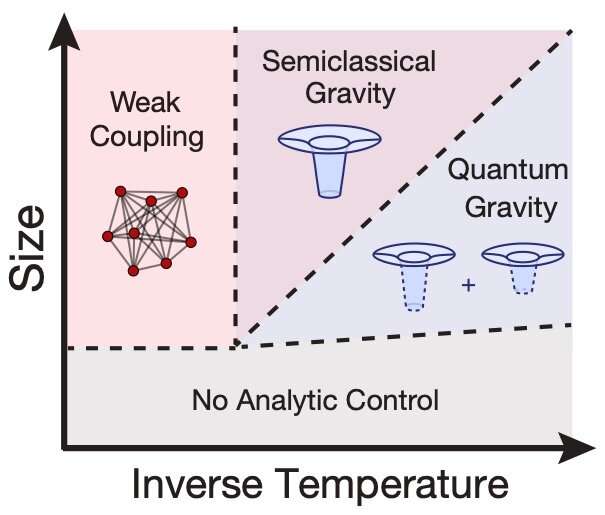February 11, 2021 feature
Researchers gather numerical evidence of quantum chaos in the Sachdev-Ye-Kitaev model

Over the past few years, many physicists worldwide have conducted research investigating chaos in quantum systems composed of strongly interacting particles, also known as many-body chaos. The study of many-body chaos has broadened the current understanding of quantum thermalization (i.e., the process through which quantum particles reach thermal equilibrium by interacting with one another) and revealed surprising connections between microscopic physics and the dynamics of black holes.
Researchers at University of California, Berkeley have recently carried out a study examining many-body chaos in the context of a renowned physical construct called the Sachdev-Ye-Kitaev (SYK) model. The SYK model describes a cluster of randomly interacting particles and was the first microscopic quantum system predicted to exhibit many-body chaos.
"Our work is motivated by the fundamental question of how quickly information can spread in strongly-interacting quantum systems," Bryce Kobrin, one of the researchers who carried out the study, told Phys.org. "A few years ago, a beautiful theoretical prediction emerged which suggested that in certain high-dimensional systems, information spreads exponentially fast, analogous to the butterfly effect in classical chaos."
In addition to hypothesizing this rapid spread of information in certain high-dimensional systems, previous studies proved that there is a universal speed limit on the rate at which this 'chaos' can develop. Interestingly, the only known or hypothesized systems that reach this limit are closely related to black holes, or more specifically, quantum theories that describe black holes. A major surprise was when researchers predicted that the SYK model also saturates the universal bound on chaos. This insight led to further analyses indicating that the low-temperature properties of the SYK model are, in effect, equivalent to that of a charged black hole.
Although these ideas have been supported by theoretical calculations, verifying their validity and observing quantum chaos in numerical simulations has so far proved to be an enduring challenge. Kobrin and his colleagues set out to investigate the chaotic nature of the SYK model. They did this by simulating the dynamics of exceptionally large systems using cutting-edge numerical techniques they developed. Subsequently, they analyzed the data they collected using a method based on calculations from quantum gravity.
"As a function of temperature, we observed the system change from behaving like ordinary interacting particles to agreeing precisely with the predicted behavior of a quantum black hole," Kobrin said. "By developing new procedures to analyze our results, we determined the rate of chaos and explicitly showed that, at low temperatures, it approached the theoretical upper bound."
Kobrin and his colleagues gathered direct numerical evidence of a new dynamical phenomenon, namely many-body chaos, which translates chaos from classical mechanics to strongly interacting quantum systems. Their findings also highlight the valuable interplay between quantum simulations and quantum gravity theories.
While in their recent study, the researchers used the numerical tools that they created to examine many-body chaos in the SYK model, in the future the same techniques could be applied to other models that are difficult to examine using common analysis frameworks. Ultimately, this could aid the ongoing search for quantum systems that exhibit the same behavior as black holes. Finally, the methods employed by this team of researchers could also inspire the development of experimental techniques to simulate quantum dynamics on controllable quantum hardware, for instance using arrays of cold atoms or trapped ions.
"I am excited to investigate other phenomena at the intersection between quantum information and quantum gravity," Kobrin said. "For example, it is predicted that by coupling together two copies of the SYK model, one can form a so-called traversable wormhole through which information can be communicated. This is a highly counterintuitive result which demonstrates that quantum chaos can, in fact, help move information from one place to another."
More information: Bryce Kobrin et al. Many-Body Chaos in the Sachdev-Ye-Kitaev Model, Physical Review Letters (2021). DOI: 10.1103/PhysRevLett.126.030602
Journal information: Physical Review Letters
© 2021 Science X Network




















